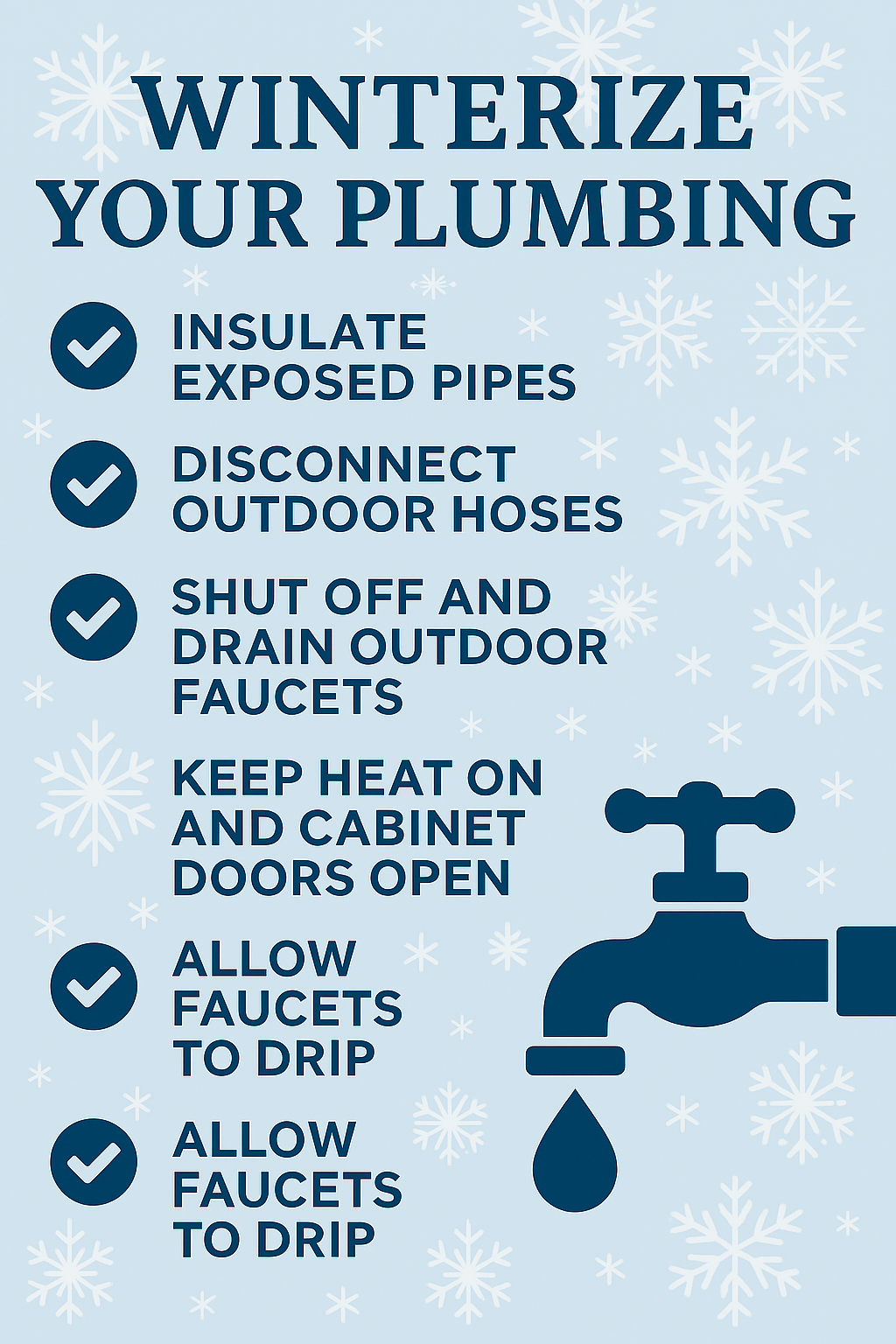Frozen pipes can cause serious damage to your home during the winter season. When water inside your pipes freezes, it expands and can lead to cracks or even burst pipes, resulting in costly repairs. That’s why it’s essential to winterize your plumbing system before temperatures drop. This guide covers everything you need to know to prevent frozen pipes and keep your home safe, warm, and dry throughout the cold months.
Why It’s Important to Winterize Plumbing and Prevent Frozen Pipes
Frozen pipes can crack or burst, resulting in leaks and significant property damage. By learning how to winterize plumbing, you reduce the risk of frozen pipes, minimize repair costs, and maintain a comfortable home environment all winter long.
Basic Steps to Winterize Plumbing and Protect Your Home’s Pipes
1. Insulate Exposed Pipes to Effectively Winterize Your Plumbing System
Exposed pipes in unheated spaces like basements, attics, or crawl spaces are highly susceptible to freezing. Use foam pipe insulation sleeves to cover any visible plumbing lines. This is one of the easiest and most affordable ways to winterize plumbing and protect your pipes from freezing temperatures.
2. Disconnect and Drain Outdoor Hoses for Plumbing Winterization
Before temperatures drop, remove garden hoses and drain water from outdoor faucets. Leaving hoses attached can cause water to freeze in the hose and damage your exterior plumbing.
3. Seal Air Leaks and Drafts to Prevent Frozen Pipes
Drafts and gaps around your home can allow cold air to reach pipes. Inspect areas such as brickwork, outdoor hose bibs, and window frames. Use caulk or spray foam to seal cracks and install insulated bib covers over outdoor faucets to keep cold air out.
4. Inspect and Replace Weatherstripping Around Windows and Doors to Maintain Plumbing Integrity
Damaged weatherstripping lets cold air in and increases the risk of frozen pipes. Inspect and replace worn or missing weatherstripping around doors, windows, and garage doors for a tighter seal.
How to Winterize Plumbing Before Going on Vacation or Extended Absence
1. Shut Off Water Supply to Protect Pipes While Away
Turn off the main water valve to stop water flow and prevent potential pipe bursts while you’re gone.
2. Keep Heating On to Maintain Safe Temperatures for Plumbing Systems
Maintain a minimum indoor temperature of around 50°F (10°C) to prevent freezing. Avoid turning your heat completely off.
3. Drain Plumbing Lines Completely to Avoid Frozen Pipes
Open all faucets to drain water from pipes, and flush toilets to empty tanks. This step helps remove water that could freeze and cause damage.
4. Set Water Heater to Vacation Mode to Safeguard Plumbing and Save Energy
If your heater has a vacation or low-energy mode, use it to save energy while still keeping water warm enough to prevent bacterial growth.
5. Clear and Unclog Drains to Ensure Proper Water Flow During Winter
Make sure all drains are clear of clogs so water doesn’t stagnate and freeze in your pipes.
Additional Winter Plumbing Protection Tips to Prevent Frozen Pipes
- Open Cabinet Doors under sinks to let warm air circulate around plumbing lines.
- Keep Garage Doors Closed if there are pipes in the garage, to protect them from cold air.
Recognizing the Signs of Frozen Pipes to Act Quickly
Watch for these warning signs:
- No water flow from faucets
- Frost or ice buildup on exposed pipes
- Strange noises like banging or clanking in walls
- Low water pressure affecting some faucets
What to Do if Pipes Freeze: Emergency Plumbing Winterization Tips
If you suspect frozen pipes, call a licensed plumber immediately. Do not attempt to thaw pipes with an open flame or heat gun as this can cause damage or fire.
